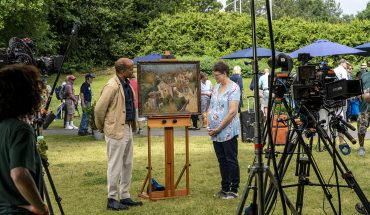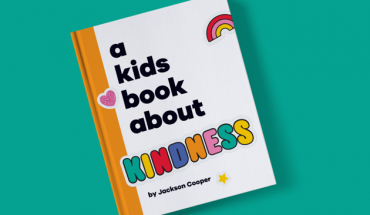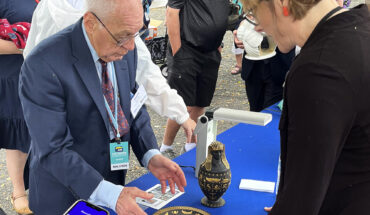Valerie Hillings brings a worldly outlook to her new role
as NCMA’s director.
by Iza Wojciechowska | photography by Justin Kase Conder

Valerie Hillings is in love with the view. Each day when she comes to work, she steps into her window-walled office and looks out onto the three enormous, iconic rings of Thomas Sayre’s Gyre, the pond next to it, and the surrounding 164 acres of The Ann and Jim Goodnight Museum Park at the North Carolina Museum of Art. “I mean, I can’t believe this view,” she says. “I just sit here every day like, ‘Am I here?’”
But as the new director and CEO of the NCMA, Hillings is most certainly here. In November, Hillings took over as only the ninth director in the museum’s 63-year history—and the first woman in the role. Larry Wheeler, who helmed the NCMA from 1994 until he retired last year, transformed the museum and put it on the map, adding the glass-clad West Building that now houses the permanent collection, developing the park, emphasizing educational and artist programming, and ensuring that artists and art lovers across North Carolina and the country knew the NCMA.
Now, after Wheeler’s 24-year tenure, Hillings has big shoes to fill. And after a 14-year career as a curator at the Guggenheim Museum, she’s more than ready to do so, with plans to expand on Wheeler’s successes and to take the museum in new directions too. Not only does she have a great view—she has truly exciting perspective.
From North Carolina to Abu Dhabi and back again
Growing up in Alexandria, Virginia, Hillings was exposed to art early on: her mother was a painter and her father’s job as an airline lobbyist allowed the family to travel often and visit museums all over the world. But Hillings was never much of an artist herself, she says, and the only artwork she ever made was at 9 years old: a pen-and-ink drawing of a cheetah that still sits on her mother’s desk. Despite the self-proclaimed lack of talent, the love of art was there, and her art history classes in high school fascinated her. But the first time she moved to the Triangle, to attend Duke University, she was headed in another direction, intending to study public policy and go to law school.
Because of a scheduling glitch, however, she found herself in an intro to art history class—and loved it. She ended up double-majoring in public policy and art history, curating a student show to finish off senior year. The prospect of law school fell by the wayside, and she went straight from college to New York University’s Institute of Fine Arts for a master’s degree, then a PhD.
“I don’t know if I always knew [I wanted to be a curator], but I knew pretty early that I wanted to be in a museum,” Hillings says. In 2004, shortly after she completed her education, the Guggenheim Museum brought her on. From 2009 to 2018, she led a team of curators in planning for the opening of the Guggenheim Abu Dhabi, currently still in development.
Though Hillings loves a good ancient or medieval collection, her expertise is in 1960s and contemporary art. She’s worked with world-class artists like Angela Bulloch, Hanne Darboven, and Marina Abramović, and she acquired a Yayoi Kusama infinity room as well as a piece by El Anatsui for the Guggenheim Abu Dhabi—both artists whose works are also on display at the NCMA. Thus, the NCMA’s large contemporary collection appealed to Hillings, and many of the featured artists were familiar faces. She was awed by the way the museum had evolved since she had been a student at Duke, when it had still been a small, one-building endeavor.
“The minute I set foot here [this time], I thought, ‘Oh my gosh—this is really a serious, serious museum’ and decided to take a chance on it,” she says. “The more I went through the [hiring] process, the more I really understood that I could walk in the collection galleries right now and give you a tour, because I know this material and I like it.”
Not only was the NCMA’s collection and artistic direction a perfect fit for Hillings, but coming back to North Carolina was a bright spot as well. She’d maintained ties with her alma mater, serving on the board of the Nasher Museum, and her in-laws live in Charlotte, where her husband is from. The two had been planning to retire in North Carolina—but now they’re here a bit ahead of schedule, and instead of winding down her career, Hillings is reaching new heights.

The future is female
When it comes to hiring museum directors, Hillings says that a recent trend favored those who came from a business background, but didn’t necessarily appreciate art. And while Hillings developed business acumen through the Center for Curatorial Leadership in New York, she very much comes to the directorial role having a deep understanding of art. It turns out that’s exactly what the NCMA was looking for.
“The fact that they wanted a director who could think about artistic vision was extremely important to me,” Hillings says. “It’s not that I’m coming here to curate shows, but I would love to be the person that thinks about the architecture with the team and thinks about the collection.”
That’s not the only trend Hillings is bucking as she settles into the director’s chair. As the NCMA’s first female director, Hillings doesn’t take that honor—or the responsibility—lightly.
“If you look at the curatorial field, there’s quite a lot of women in it. But even until recently, a lot of [museum] directorships were not held by women,” she says. “So I feel very proud that I took a chance, applied for the bigger job, got the bigger job—and I’m looking forward to doing a good job in the bigger job.” Moreover, at just 47 years old, Hillings is of a younger generation than the typical museum director, and she’s excited to work at an institution that was willing to make a “double statement.” As a woman in a male-dominated position, and with her younger perspective but still vast experience in the art world, Hillings is a force to be reckoned with—and a role model for women in the field and those who hope to enter it.
“As a woman who has worked in the museum field for over 30 years, and at this particular moment in time, I am thrilled to be at the museum for our first female director,” says Linda Dougherty, the NCMA’s chief curator and curator of contemporary art. “I’m looking forward to working with someone who really understands my role and responsibilities because of her firsthand experience. I’m looking forward to new ideas and possibilities for the museum.”
Big ideas
She may be new to the job, but that hasn’t stopped Hillings from hitting the ground running and figuring out how to move the museum forward.
First, on a conceptual level, she’s interested in connecting art from disparate times and places via historical throughlines. In other words, she wants the curatorial team to examine how works of art are related across human and creative history in ways that aren’t just chronological or geographical, as is traditional in a museum.
“That’s something that, as I walk through the collection galleries, I start to see. I imagine some different configurations, some different stories that could be very interesting,” Hillings says. “It’s an opportunity, on one hand, for those that prefer contemporary art to actually look at older art, and for those that prefer older art to recognize that was contemporary art at one time. I think that’s really important.”
She’s also eager for the museum to originate more exhibitions, in order to showcase the curators’ interests and talents and to become more of a pioneer in the museum experience. She points to last year’s You Are Here exhibit, featuring dynamic light and sound installations. The NCMA originated You Are Here, and it brought in double the number of visitors expected.
“The curators put those things together. They made that show,” Hillings says. “That’s a very exciting thing, and that also takes the NCMA outside its borders as a leader in the field.” For Hillings, exploring more exhibits along those lines is “the logical next step in the process.”
A jewel in the NCMA’s crown is its educational and artistic programming, with everything from artist conversations to professional development workshops, teacher fellowships, and thematic symposia in partnership with area universities. Films and concerts in the park are offered for audiences of all ages, and interactive experiences in the evenings draw young adult crowds. The breadth and creativity of the programming means there’s something for everyone at the NCMA.
“You see people convening—school groups wandering through, older ladies coming in for lunch and talking about art, or people coming just to use the amphitheater or to go jogging in the park,” Hillings says. “I really see the museum as a place of convening and encountering. Not just encounters with the art—but encounters with people.”
She hopes to foster these experiences by encouraging educators to incorporate the NCMA collection—which was the first to be purchased with public funds by a U.S. museum—into the state’s core curriculum and by establishing stronger partnerships with universities.
Finally, Hillings also looks forward to championing and expanding the Matrons of the Arts initiative, launched last year, which highlights female artists from around the world through acquisitions, exhibits, and programming; promoting conservation; and finding creative ways to knit the three disparate elements of the museum—the brick East Building, the glass West Building, and the park—together in programmatic and perhaps unconventional ways.
Not a bad set of goals to get started in a new job. Luckily, Hillings’s experience as a curator keeps her grounded, and she’s no stranger to taking on challenging projects. She’s eager to put down roots here in North Carolina—and North Carolina is certainly excited to see what she does with the place.
“I’m learning a ton that’s new, but there’s a ton that’s like putting on an old comfortable sweater,” Hillings says. “I love museums, I understand museums, and I think just really understanding what this museum can be will take time. But I’m glad to be knee-deep in that
challenge and that conversation.”



